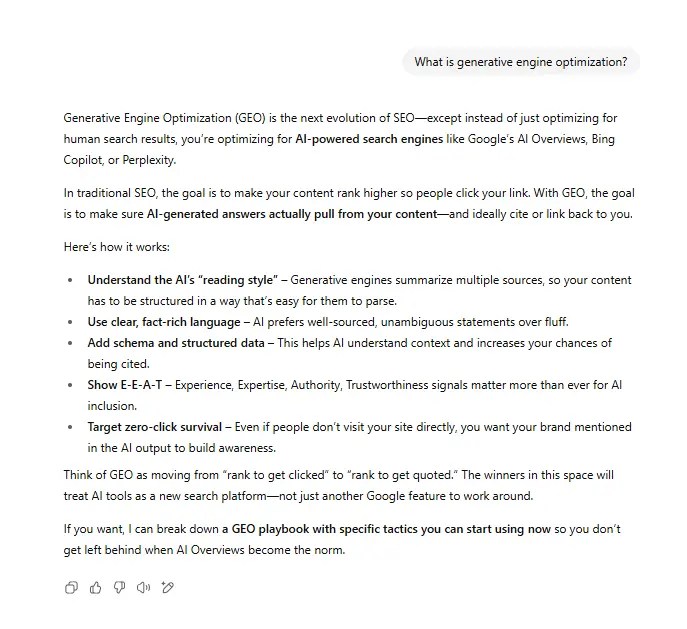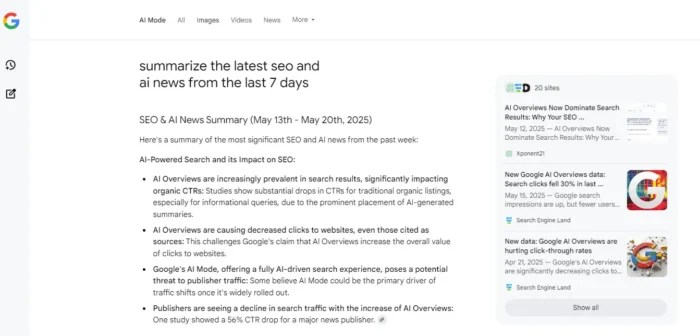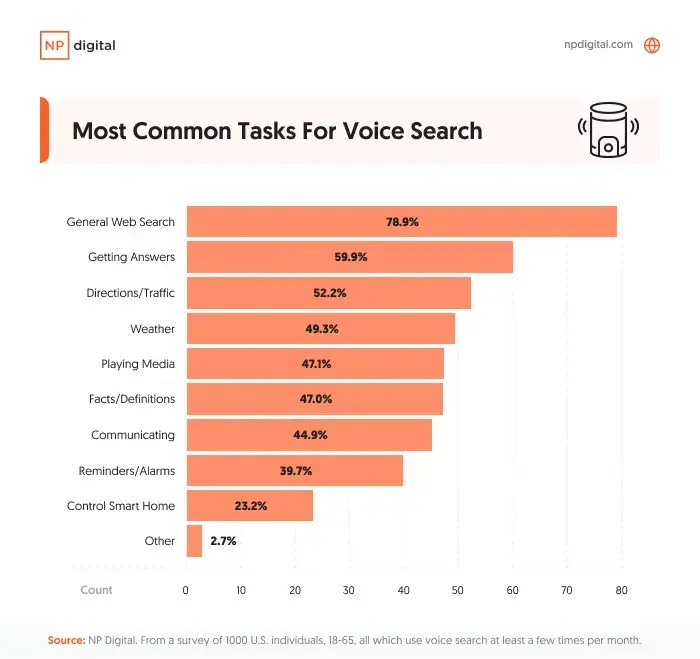LLM Optimization (LLMO): How to Rank in AI-Driven Search
You’re not alone if you’ve noticed your organic traffic dipping while your content continues to rank. And you’re not imagining it. Nowadays, people skip clicking to websites and get answers to their questions straight from AI platforms like ChatGPT, Perplexity, or Google’s AI Overviews.
Welcome to the new reality, where AI reshapes how users search and brands that fail to adapt risk fading from the conversation.
How do we deal with this? LLM optimization (LLMO).
LLMO isn’t a furry red puppet from a kid’s TV show. Nor is it just another SEO tactic. It’s the next evolution in search visibility, one designed to help your brand show up when large language models (LLMs) generate answers instead of serving up traditional search results.
The good news is that most companies aren’t currently doing it, and that’s an edge you can use to your advantage.
Below, we’ll explore how LLMO works, why it matters, and concrete strategies you can use to get your brand into AI-generated answers before your competitors.
Key Takeaways
- LLM optimization (LLMO) is the evolution of SEO. It focuses on getting your brand cited and recommended inside AI answers, not just ranked on traditional search results pages.
- Ignoring LLMO means lost visibility. Even if your rankings stay strong, AI-generated answers can push you out of the conversation.
- Three pillars drive LLMO success: authoritative content (E-E-A-T), structured data (schema, FAQs, HowTos), and consistent tracking of AI citations.
- Winning early matters. Most brands have yet to optimize for AI, so moving now gives you a competitive edge.
- Think beyond Google. AI models pull from multiple platforms, including digital public relations (DPR), backlinks, and multi-format content across trusted spaces, boosting your chances of being included in answers.
What is LLM Optimization?
LLMO is increasing your brand’s visibility in AI-generated answers from large language models like Gemini, Perplexity, Claude, and ChatGPT. You can think of it as the next evolution of SEO.
Traditional SEO helps you rank in search engine results. LLMO helps you get cited, mentioned, and recommended inside AI responses. Instead of blue links on a SERP, these are full-text answers where being included often means you’re the answer.
So, what makes this different from LLM SEO?
LLM SEO typically focuses on targeting AI Overviews or how LLMs pull from search engine results. LLMO goes broader. It focuses on structuring content, strengthening brand authority, and ensuring visibility across any LLM platform, not just Google’s.
More so than ranking highly, LLMO focuses on showing up when users don’t even click.

Perplexity’s results when asked for the best backpacks for work.

ChatGPT’s recommendations for the same question.
How LLMs Work
LLMs don’t search the web in real time (unless they use retrieval methods). Instead, they generate responses based on patterns in their training data, which comprises billions of words from sources such as websites, books, Wikipedia, Reddit, and more.
Here’s how it works: When you type a prompt, the LLM predicts the most likely next word based on everything it’s seen before. That prediction continues word-by-word until it builds a full response.
What makes this a big deal for marketers?
LLMs favor content that’s:
- Clear and easy to understand
- Well-structured and logically organized
- Fact-based
- Published or associated with trusted sources
If your content meets these standards (and exists in places LLMs train on), it has a higher chance of showing up in those responses. The goal is no longer to rank in search alone, but to be seen as a reliable part of the internet’s knowledge base.
Bottom line: if your content isn’t clear, structured, and published in trusted places, LLMs won’t see you as credible.
The Impact of LLMs On How We Gather Information
LLMs have changed how people search.
Instead of relying on ten blue links or blog posts for information, users ask questions and get complete answers without leaving the AI experience or SERP. That shift creates even more “zero-click” moments, where users don’t visit your site because the AI already gave them the needed answer.
That’s a big deal if your brand relies on traffic. You could be the best at what you do, but users may never know (or forget) you exist if you’re not part of the AI-generated answer.
That means the rules have changed. Visibility now depends on whether LLMs see and trust your content; failing to actively optimize for that means you’re already falling behind.
Why LLM Optimization is Important
If you’ve relied on traditional SEO alone, you’ve seen the warning signs: traffic dropping even though rankings haven’t moved. Users aren’t clicking. They’re getting their answers straight from AI. How many? The number can vary, but according to some estimates, ChatGPT boasts more than 700 million weekly active worldwide users. Perplexity had 22 million active users in May 2025.
Marketers who ignore LLMO risk losing visibility. Your brand may have great rankings, backlinks, and content, but if LLMs don’t include you in their answers, you’re no longer in the conversation. And that means fewer impressions, clicks, or opportunities to win customers.
There’s a flipside, though. Marketers who adapt today get an advantage over their competitors. LLMs reward trustworthy, structured content that speaks with authority. When you optimize for AI-driven search, you position your brand to appear where people make decisions: inside the answers they read, not just on the links they skip.
The TL;DR? LLMO is the new baseline for staying visible in an AI-first search reality.
How to Optimize for LLMs
LLMO comes down to three pillars:
- Creating authoritative content
- Structure content so AI can understand it
- Track brand presence AI responses
Nail these three, and you’re on your way to AI-driven visibility. But how do you do that?
Create Content LLMs Trust
LLMs look for reliable content. That means well-cited, comprehensive content written by people (or brands) who clearly know their stuff. This concept should feel familiar. In SEO terms, we describe it as E-E-A-T: experience, expertise, authority, and trust.
For example, a medical publisher cites peer-reviewed studies and has licensed doctors writing the content. Google and AI models treat this as more trustworthy than a generic health or wellness blog.

Perplexity sources information from reputable organizations like the Cleveland Clinic and Nature to answer this question.
Your goal is the same. Back up your claims with relevant, recent stats. Link to reputable sources. Build depth into your content. The more proof points you provide, the more likely LLMs will pull your information into their responses.
Use Structured Data and Schema
LLMs thrive on structure. Schema markup helps you present content in a way that AI systems can easily recognize and cite. We’ve been talking about the benefits of schema for years, but focus on practical formats that are easy to implement:
- FAQ schema for common questions
- HowTo schema for step-by-step guides
- Article schema for blog posts and thought leadership
- Product schema to highlight price and customer reviews
Implementing schema isn’t complicated, either. Tools like Rank Math or Yoast often make it as easy as filling out a form. The payoff is that your content becomes easier for AI to parse, increasing your odds of being referenced in the outputs.
Schema gives LLMs a cheat sheet to your content by telling them exactly what’s on the page and why it matters.
Optimize for Conversational and Long-Tail Queries
Unlike search engines, which primarily reward keywords, LLMs excel at answering natural, human-style questions. That’s why your content should target long-tail and conversational phrases.
Here’s how to adopt:
- Pull inspiration from the “People Also Ask” results, Reddit threads, and Quora discussions. Read the titles of posts and questions on enthusiast or product-specific forums and subreddits, and create content to answer them.
- Frame subheadings as real questions. Instead of “LLMO Strategy,” try “How do you optimize for LLMs?”
- Expand your FAQs with the same language your audience uses.

The People Also Ask box on Google’s SERP provides excellent questions to think about answering, if you haven’t already.
Let’s say someone wants to know more about this topic. The keyword AI brand optimization (boring, dry) could become “How do I make my brand visible in AI search?” That’s the kind of phrasing LLMs are built to surface.
When you align your content to how people naturally ask questions, you increase your odds of citation inside answers instead of being skipped over.
Build Topical Authority Across Clusters
One-off articles won’t cut it to establish authority. Both LLMs and search engines are better at recognizing brands that demonstrate expertise across a subject, not just a single page. Topic clusters are the way to meet this demand.
Topic clusters connect one in-depth “pillar” page to multiple related posts. For example, a pillar page might target LLM optimization, while cluster posts examine topics like schema, E-E-A-T, AI metrics, and long-tail queries (all of which we’ve mentioned—or will mention—in this post).
Each post links back to the pillar and the others, creating a web of authority. That signals to LLMs (and Google) that your brand owns the topic, not just a slice of it. The more complete your coverage, the more likely it is your content will surface in AI-generated answers.
Earn High-Authority Backlinks and Mentions
LLMs trust what the internet trusts. That means your brand needs backlinks and mentions from credible sources. Three major ways to earn backlinks include:
- Digital PR: Pitch stories or data insights to journalists.
- Original research: Publish statistics or case studies that others naturally cite.
- Guest contributions: Share expertise from and on authoritative sites in your industry.
Don’t stop there, though. Regularly audit your backlink profile to clean out low-quality or spammy links. The more respected websites reference your brand, the more likely it becomes part of those AI-driven conversations due to credibility.
Implement Multi-Format Content
LLMs love clarity; the easier your content is to scan and summarize, the higher the chance it gets used. Even better, many of the same tactics that make it simpler for readers to parse are good for LLMs, too. Some practical tips for your content include:
- Use bullet points and numbered steps for key processes.
- Add tables to organize comparisons or data.
- Include visuals such as screenshots, annotated images, or infographics (complete with alt text).
Why do these things work? Structured, multi-format content gives AI models more “hooks” to grab onto. Instead of parsing dense paragraphs, they can quickly identify and cite your answers. Don’t think of it as writing for AI. Think of it as making it friendlier: clear, structured, and easy to reuse.
Monitor AI-Specific Citations
You can’t improve what you don’t track. AI visibility is now a critical KPI. You can monitor it both manually and with reporting tools. Start by asking the LLM platforms questions about your search terms and content, and see where you (or your competitors) appear. With that knowledge, you can adjust content and regularly recheck it.
Of course, manual work can take a lot of time. Tools like Semrush’s AI Tracking, Ubersuggest LLM Beta, and Ahrefs Brand Radar let you see how often AI platforms cite your answers. Look for the following elements as part of your regular reporting:
- Branded mentions inside chat responses
- Citations for specific queries
- Share of voice compared to competitors
These insights reveal content gaps and help guide your next moves. For example, if competitors are being cited for a topic you cover but you’re not cited, that’s your cue to strengthen authority or update your content.
Tracking AI citations is the feedback loop to keep your LLMO strategy moving forward.

Ahrefs’ Brand Radar shows mentions and impressions for the most popular AI dashboards.
Search Everywhere Optimization and LLMO
Search is no longer confined to Google. Users today find their answers on social media, Reddit, YouTube, and AI platforms. Search Everywhere Optimization ties directly into LLMO.
When you optimize for visibility across all platforms, you create more entry points for LLMs to pull from. When your brand is active in multiple trusted spaces, you’re far more likely to be included in AI answers.
How To Track LLM Visibility
You can’t treat LLMO like traditional SEO unless you know where you’re showing up. Tracking AI visibility allows you to measure progress, spot gaps, and benchmark against your competitors. So, what should you measure?
- Branded Mentions in AI Responses: Check how often your brand name or content appears in outputs from ChatGPT, Perplexity, Gemini, and Claude, among others. Seek out both direct mentions and co-citations with your competitors.
- Topic-Level Inclusion: Search AI models for industry-specific queries. If competitors are cited but you aren’t, that’s a red flag.
- Traffic from LLMs: Tools like GA4 can help you track referral traffic. Sometimes using Looker Studio templates can help you separate the AI referrals from organic traffic.
- Share of Voice in AI: The platforms we mentioned above—Semrush, Ubersuggest, and Ahrefs Brand Radar—can provide dashboards that show your brand mentions across queries.
There are upcoming tools that combine several of these different functionalities as well, such as Profound. LLM visibility won’t replace your existing analytics; it’s another tool in your ranking report. Instead of asking “Where do I rank in Google?”, you’ll ask, “Where do I appear in AI answers?”
The data you collect here is really important. It shows you which strategies are working and allows you to double down on the ones that matter most.
FAQs
What is LLMO?
LLMO stands for large language model optimization. It’s the practice of making your brand, content, and data more visible in AI-generated answers likeChatGPT, Claude, Gemini, and Perplexity.
How is LLMO different from SEO?
SEO helps you rank in traditional search engines. LLMO ensures you’re included in AI responses. Both are important, but LLMO addresses the “zero-click” future of search.
How do I get my brand into LLM responses?
Focus on three pillars: authoritative content (E-E-A-T), structured data (schema, FAQs, HowTos, Product), and monitoring AI citations. Add digital PR, backlinks, and multi-format content to increase the chances your expertise is recognized and surfaced.
How long does LLM optimization take?
Like SEO, results don’t happen overnight. But unlike SEO, you can sometimes see brand mentions in LLMs faster, especially if your content is well-cited and already trusted.
What tools track AI visibility?
Early options include Semrush AI Tracking, Ubersuggest LLM Beta, and Ahrefs Brand Radar. You can also use GA4 to measure referral traffic from LLM-powered search engines like ChatGPT.
Do backlinks still matter for LLMO?
Yes. LLMs lean on credible, widely cited sources. High-authority backlinks increase your chances of being trusted and surfaced in AI answers.
Can small businesses benefit from LLMO?
Absolutely. In fact, moving early is an advantage. If competitors aren’t optimizing yet, you can claim visibility before they catch up.
Conclusion
AI-driven search is not the future because it’s already here.
If you want your brand to stay visible, think outside the blue link box and start optimizing for where people get their answers. That’s the promise of LLM optimization.
The playbook? Simple: Create trustworthy content and structure it so AI can understand it. Once it’s in place, track how often you show up in responses like AI Overviews and ChatGPT. As you layer in topic clusters, a strong digital PR push, and multi-format assets, you’ll give your brand every chance to surface where it counts.
Companies that adapt today will own tomorrow’s conversation. The ones who won’t risk losing visibility and becoming yesterday’s news, even if their SEO fundamentals look good on paper.
If you’re ready to learn how to turn your content into AI-worthy assets, we can help. Contact us today for your consultation.
Read more at Read More





































 Clicks: +7.8%
Clicks: +7.8% CPC: -8.3%
CPC: -8.3%





























































